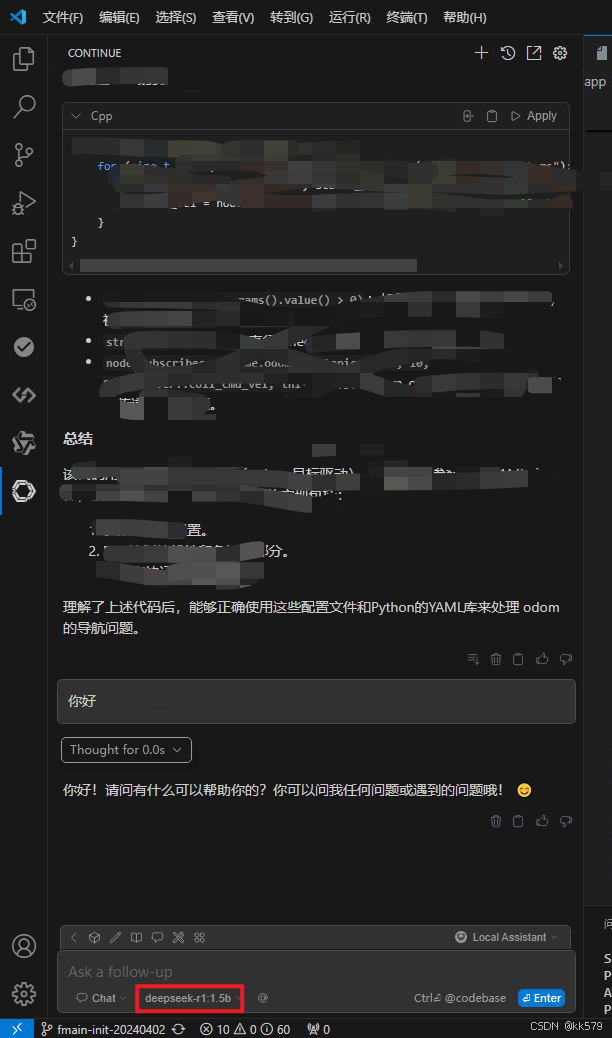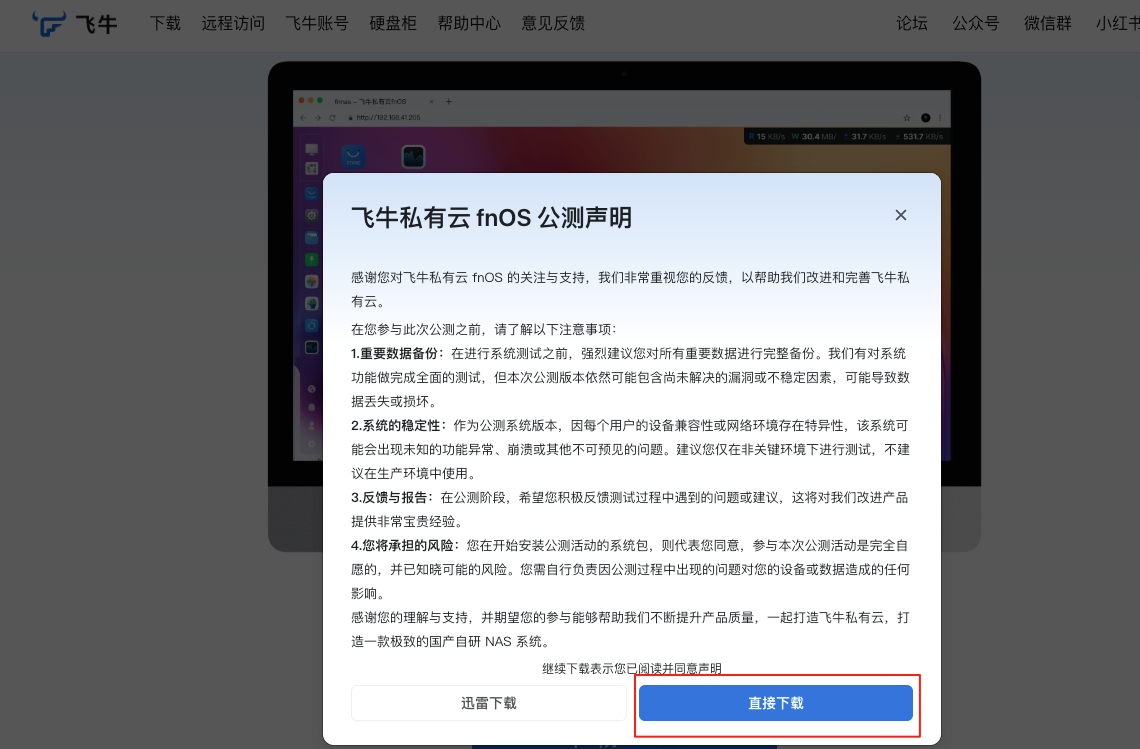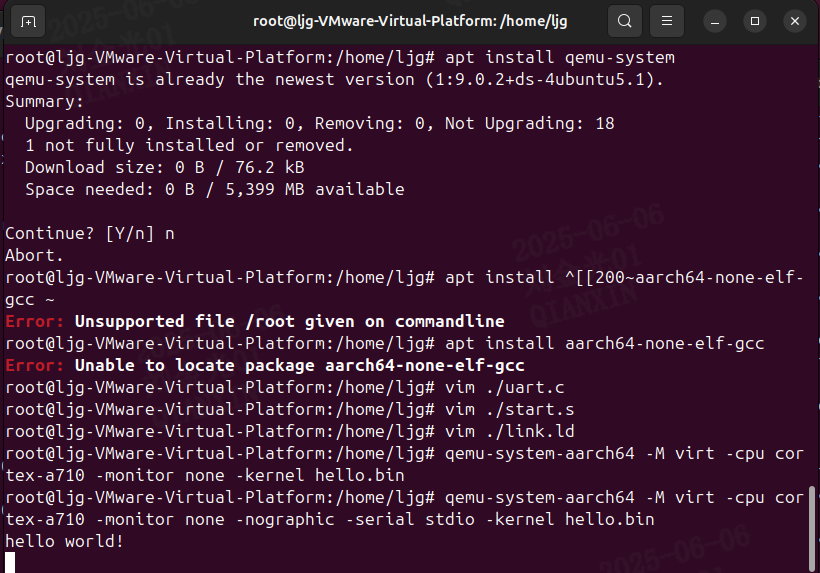Chatper 4: Implementing a GPT model from Scratch To Generate Text
文章目录
- 4 Implementing a GPT model from Scratch To Generate Text
- 4.1 Coding an LLM architecture
- 4.2 Normalizing activations with layer normalization
- 4.3 Implementing a feed forward network with GELU activations
- 4.4 Adding shortcut connections
- 4.5 Connecting attention and linear layers in a transformer block
- 4.6 Coding the GPT model
- 4.7 Generating text
- 4.8 Summary
4 Implementing a GPT model from Scratch To Generate Text
-
本章节包含
- 编写一个类似于GPT的大型语言模型(LLM),这个模型可以被训练来生成类似人类的文本。
- Normalizing layer activations to stabilize neural network training
- 在深度神经网络中添加shortcut connections,以更有效地训练模型
- 实现 Transformer 模块以创建不同规模的 GPT 模型
- 计算 GPT 模型的参数数量及其存储需求
在上一章中,学习了多头注意力机制并对其进行了编码,它是LLMs的核心组件之一。在本章中,将编写 LLM 的其他构建块,并将它们组装成类似 GPT 的模型

4.1 Coding an LLM architecture
-
诸如GPT和Llama等模型,基于原始Transformer架构中的decoder部分,因此,这些LLM通常被称为"decoder-like" LLMs,与传统的深度学习模型相比,LLM规模更大,这主要归因于它们庞大的参数数量,而非代码量。因为它的许多组件都是重复的,下图提供了类似 GPT LLM 的自上而下视图

本章将详细构建一个最小规模的GPT-2模型(1.24亿参数),并展示如何加载预训练权重以兼容更大规模的模型。
-
1.24亿参数GPT-2模型的配置细节包括:
GPT_CONFIG_124M = {"vocab_size": 50257, # Vocabulary size"context_length": 1024, # Context length"emb_dim": 768, # Embedding dimension"n_heads": 12, # Number of attention heads"n_layers": 12, # Number of layers"drop_rate": 0.1, # Dropout rate"qkv_bias": False # Query-Key-Value bias }我们使用简短的变量名以避免后续代码行过长
"vocab_size"词汇表大小,由 BPE tokenizer 支持,值为 50,257。"context_length"模型的最大输入标记数量,通过 positional embeddings 实现。"emb_dim"token输入的嵌入大小,将每个token转换为 768 维向量。"n_heads"多头注意力机制中的注意力头数量。"n_layers"是模型中 transformer 块的数量"drop_rate"是 dropout 机制的强度,第 3 章讨论过;0.1 表示在训练期间丢弃 10% 的隐藏单元以缓解过拟合"qkv_bias"决定多头注意力机制(第 3 章)中的Linear层在计算查询(Q)、键(K)和值(V)张量时是否包含偏置向量;我们将禁用此选项,这是现代 LLMs 的标准做法;然而,我们将在第 5 章将 OpenAI 的预训练 GPT-2 权重加载到我们的重新实现时重新讨论这一点。
-
下图中的方框展示了我们为实现最终 GPT 架构所需处理的各个概念的顺序。我们将从第一步开始,即一个我们称为 DummyGPTModel 的 GPT 骨架占位符:

import torch import torch.nn as nnclass DummyGPTModel(nn.Module):def __init__(self, cfg):super().__init__()self.tok_emb = nn.Embedding(cfg["vocab_size"], cfg["emb_dim"])self.pos_emb = nn.Embedding(cfg["context_length"], cfg["emb_dim"])self.drop_emb = nn.Dropout(cfg["drop_rate"])# Use a placeholder for TransformerBlockself.trf_blocks = nn.Sequential(*[DummyTransformerBlock(cfg) for _ in range(cfg["n_layers"])])# Use a placeholder for LayerNormself.final_norm = DummyLayerNorm(cfg["emb_dim"])self.out_head = nn.Linear(cfg["emb_dim"], cfg["vocab_size"], bias=False)def forward(self, in_idx):batch_size, seq_len = in_idx.shapetok_embeds = self.tok_emb(in_idx)pos_embeds = self.pos_emb(torch.arange(seq_len, device=in_idx.device))x = tok_embeds + pos_embedsx = self.drop_emb(x)x = self.trf_blocks(x)x = self.final_norm(x)logits = self.out_head(x)return logitsclass DummyTransformerBlock(nn.Module):def __init__(self, cfg):super().__init__()# A simple placeholderdef forward(self, x):# This block does nothing and just returns its input.return xclass DummyLayerNorm(nn.Module):def __init__(self, normalized_shape, eps=1e-5):super().__init__()# The parameters here are just to mimic the LayerNorm interface.def forward(self, x):# This layer does nothing and just returns its input.return xDummyGPTModel:简化版的 GPT 类模型,使用 PyTorch 的nn.Module实现。- 模型组件:包括标记嵌入、位置嵌入、丢弃层、变换器块、层归一化和线性输出层。
- 配置字典:配置通过 Python 字典传入,如
GPT_CONFIG_124M,用于传递模型配置。 forward方法:描述数据从输入到输出的完整流程。计算嵌入 → 应用 dropout → 通过 transformer blocks 处理 → 应用归一化 → 生成 logits。- 占位符:
DummyLayerNorm和DummyTransformerBlock是待实现的组件。
-
数据流动:下图提供了 GPT 模型中数据流动的高层次概述。

使用 tiktoken 分词器对由 GPT 模型的两个文本输入组成的批次进行分词:
import tiktokentokenizer = tiktoken.get_encoding("gpt2")batch = []txt1 = "Every effort moves you" txt2 = "Every day holds a"batch.append(torch.tensor(tokenizer.encode(txt1))) batch.append(torch.tensor(tokenizer.encode(txt2))) batch = torch.stack(batch, dim=0) print(batch)"""输出""" tensor([[6109, 3626, 6100, 345],[6109, 1110, 6622, 257]])接下来,我们初始化一个包含 1.24 亿参数的 DummyGPTModel 实例,并将 tokenized batch 输入其中。
torch.manual_seed(123) model = DummyGPTModel(GPT_CONFIG_124M)logits = model(batch) print("Output shape:", logits.shape) print(logits)"""输出""" Output shape: torch.Size([2, 4, 50257]) tensor([[[-0.9289, 0.2748, -0.7557, ..., -1.6070, 0.2702, -0.5888],[-0.4476, 0.1726, 0.5354, ..., -0.3932, 1.5285, 0.8557],[ 0.5680, 1.6053, -0.2155, ..., 1.1624, 0.1380, 0.7425],[ 0.0447, 2.4787, -0.8843, ..., 1.3219, -0.0864, -0.5856]],[[-1.5474, -0.0542, -1.0571, ..., -1.8061, -0.4494, -0.6747],[-0.8422, 0.8243, -0.1098, ..., -0.1434, 0.2079, 1.2046],[ 0.1355, 1.1858, -0.1453, ..., 0.0869, -0.1590, 0.1552],[ 0.1666, -0.8138, 0.2307, ..., 2.5035, -0.3055, -0.3083]]],grad_fn=<UnsafeViewBackward0>)- 输出张量:输出张量有两行,分别对应两个文本样本。每个文本样本由 4 个标记组成;每个标记是一个 50,257 维的向量,这与标记器的词汇表大小一致。
- 嵌入维度:50,257 维对应词汇表中的唯一标记,后处理阶段将其转换回 token IDs 并解码为单词。
4.2 Normalizing activations with layer normalization
通过层归一化(Layer Normalization)对激活值进行归一化处理。
-
Layer normalization (LayerNorm):将激活值中心化到均值为 0,归一化方差为 1,稳定训练并加速收敛。
应用位置:
-
transformer block 中的 multi-head attention module 前后。
-
最终输出层之前。
下图提供了LayerNormalization的直观概述

从一个小例子看看LayerNormalization发生了什么
torch.manual_seed(123)batch_example = torch.randn(2, 5) layer = nn.Sequential(nn.Linear(5, 6), nn.ReLU()) out = layer(batch_example) print(out) print(out.shape)# 计算均值和方差 mean = out.mean(dim=-1, keepdim=True) var = out.var(dim=-1, keepdim=True)print("Mean:\n", mean) print("Variance:\n", var)out_norm = (out - mean) / torch.sqrt(var) print("Normalized layer outputs:\n", out_norm)mean = out_norm.mean(dim=-1, keepdim=True) var = out_norm.var(dim=-1, keepdim=True) print("Mean:\n", mean) print("Variance:\n", var)"""输出""" tensor([[0.2260, 0.3470, 0.0000, 0.2216, 0.0000, 0.0000],[0.2133, 0.2394, 0.0000, 0.5198, 0.3297, 0.0000]],grad_fn=<ReluBackward0>)torch.Size([2, 6])Mean:tensor([[0.1324],[0.2170]], grad_fn=<MeanBackward1>)Variance:tensor([[0.0231],[0.0398]], grad_fn=<VarBackward0>)Normalized layer outputs:tensor([[ 0.6159, 1.4126, -0.8719, 0.5872, -0.8719, -0.8719],[-0.0189, 0.1121, -1.0876, 1.5173, 0.5647, -1.0876]],grad_fn=<DivBackward0>)Mean:tensor([[9.9341e-09],[0.0000e+00]], grad_fn=<MeanBackward1>) Variance:tensor([[1.0000],[1.0000]], grad_fn=<VarBackward0>)归一化会独立应用于两个输入(行)中的每一个;使用
dim=-1表示在最后一个维度(在本例中为特征维度)上进行计算,而不是在行维度上进行计算。

关闭科学计数法
torch.set_printoptions(sci_mode=False) #关闭科学计数法 print("Mean:\n", mean) print("Variance:\n", var)"""输出""" Mean:tensor([[ 0.0000],[ 0.0000]], grad_fn=<MeanBackward1>) Variance:tensor([[1.0000],[1.0000]], grad_fn=<VarBackward0>) -
-
LayerNorm类实现:基于归一化思路,实现一个LayerNorm类,稍后我们可以在 GPT 模型中使用它class LayerNorm(nn.Module):def __init__(self, emb_dim):super().__init__()self.eps = 1e-5self.scale = nn.Parameter(torch.ones(emb_dim))self.shift = nn.Parameter(torch.zeros(emb_dim))def forward(self, x):mean = x.mean(dim=-1, keepdim=True)var = x.var(dim=-1, keepdim=True, unbiased=False)norm_x = (x - mean) / torch.sqrt(var + self.eps)return self.scale * norm_x + self.shift层归一化公式(上面的例子中 γ = 1 \gamma = 1 γ=1 、 β = 0 \beta=0 β=0、 ϵ = 0 \epsilon = 0 ϵ=0)
L a y e r N o r m ( x i ) = γ ⋅ x i − μ σ 2 + ϵ + β LayerNorm(x_i) = \gamma \cdot \frac{x_i-\mu}{\sqrt{\sigma^2 + \epsilon}} + \beta LayerNorm(xi)=γ⋅σ2+ϵxi−μ+β
其中-
μ 、 σ 2 \mu 、 \sigma^2 μ、σ2 分别x在layer维度上的均值和方差
-
γ 、 β \gamma 、\beta γ、β 是可学习的缩放平移参数
-
ϵ \epsilon ϵ 是一个小常数,用于防止除零错误。
scale和shift:可训练参数,用于在归一化后调整数据的缩放和偏移。有偏方差:在上述方差计算中,设置
unbiased=False,意味着使用公式 ∑ i ( x − x ‾ ) n \frac{\sum_i(x- \overline x)}{n} n∑i(x−x),不包含贝塞尔校正。其中 n 是样本大小(此处为特征或列的数量);该公式不包含贝塞尔校正(即在分母中使用n-1),因此提供的是方差的有偏估计。(对于 LLMs,嵌入维度n非常大,使用 n 和n-1之间的差异可以忽略不计,GPT-2 是在归一化层中使用有偏方差进行训练的,因此为了与后续章节中加载的预训练权重兼容,我们也采用了这一设置。)ln = LayerNorm(emb_dim=5) out_ln = ln(batch_example) mean = out_ln.mean(dim=-1, keepdim=True) var = out_ln.var(dim=-1, unbiased=False, keepdim=True)print("Mean:\n", mean) print("Variance:\n", var)"""输出""" Mean:tensor([[ -0.0000],[ 0.0000]], grad_fn=<MeanBackward1>) Variance:tensor([[1.0000],[1.0000]], grad_fn=<VarBackward0>) -
-
所以、本节至此,我们介绍了实现GPT架构所需的构建块之一,如下图中打勾的部分

4.3 Implementing a feed forward network with GELU activations
-
本节即将实现子模块,用于transformer block(变换器块)的一部分。为此,我们需要从激活函数开始。
深度学习中,ReLU因其简单和有效而被广泛使用。但在大语言模型中,还使用了GELU和SwiGLU这两种更复杂、平滑的激活函数,它们结合了高斯和sigmoid门控,提升了模型性能,与ReLU的简单分段线性不同。
-
GELU(Hendrycks 和 Gimpel,2016)可以通过多种方式实现;其精确版本定义为 GELU(x)=x⋅Φ(x),其中 Φ(x) 是标准高斯分布的累积分布函数。
在实践中,通常会实现一种计算成本更低的近似版本:
GELU ( x ) ≈ 0.5 ⋅ x ⋅ ( 1 + tanh [ 2 π ⋅ ( x + 0.044715 ⋅ x 3 ) ] ) \text{GELU}(x) \approx 0.5 \cdot x \cdot \left(1 + \tanh\left[\sqrt{\frac{2}{\pi}} \cdot \left(x + 0.044715 \cdot x^3\right)\right]\right) GELU(x)≈0.5⋅x⋅(1+tanh[π2⋅(x+0.044715⋅x3)])
(原始的 GPT-2 模型也是使用此近似版本进行训练的)。class GELU(nn.Module):def __init__(self):super().__init__()def forward(self, x):return 0.5 * x * (1 + torch.tanh(torch.sqrt(torch.tensor(2.0 / torch.pi)) * (x + 0.044715 * torch.pow(x, 3))))import matplotlib.pyplot as pltgelu, relu = GELU(), nn.ReLU()# Some sample data x = torch.linspace(-3, 3, 100) y_gelu, y_relu = gelu(x), relu(x)plt.figure(figsize=(8, 3)) for i, (y, label) in enumerate(zip([y_gelu, y_relu], ["GELU", "ReLU"]), 1):plt.subplot(1, 2, i)plt.plot(x, y)plt.title(f"{label} activation function")plt.xlabel("x")plt.ylabel(f"{label}(x)")plt.grid(True)plt.tight_layout() plt.show()

如上图所示
-
ReLU:分段线性函数,正输入直接输出,负输入输出零。
ReLU的局限性: 零处有尖锐拐角,可能增加优化难度;对负输入输出零,限制了负输入神经元的作用。
-
GELU:平滑非线性函数,近似 ReLU,对负值具有非零梯度(除了在约-0.75处之外)
GELU的优势:平滑性带来更好的优化特性;对负输入输出较小的非零值,使负输入神经元仍能贡献学习过程。
-
-
接下来让我们使用 GELU 函数来实现小型神经网络模块 FeedForward,稍后我们将在 LLM 的转换器块中使用它:
class FeedForward(nn.Module):def __init__(self, cfg):super().__init__()self.layers = nn.Sequential(nn.Linear(cfg["emb_dim"], 4 * cfg["emb_dim"]),GELU(),nn.Linear(4 * cfg["emb_dim"], cfg["emb_dim"]),)def forward(self, x):return self.layers(x)上述的前馈模块是包含两个线性层和一个GELU激活函数的小神经网络,在1.24亿参数的GPT模型中,用于处理嵌入大小为768的令牌批次。
print(GPT_CONFIG_124M["emb_dim"])"""输出""" 768

初始化一个新的前馈网络(FeedForward)模块,其 token 嵌入大小为 768,并向其输入一个包含 2 个样本且每个样本有 3 个 token 的批次输入。我们可以看到,输出张量的形状与输入张量的形状相同:
ffn = FeedForward(GPT_CONFIG_124M)# input shape: [batch_size, num_token, emb_size] x = torch.rand(2, 3, 768) out = ffn(x) print(out.shape)"""输出""" torch.Size([2, 3, 768])本节的前馈模块对模型学习和泛化至关重要。它通过内部扩展嵌入维度到更高空间,如下图所示,然后应用GELU激活,最后收缩回原维度,以探索更丰富的表示空间。
前馈神经网络中层输出的扩展和收缩的图示。首先,输入值从 768 个值扩大到 4 倍,达到 3072 个值。然后,第二层将 3072 个值压缩回 768 维表示。

-
本节至此,现在已经实现了 下图中LLM 的大部分构建块(打勾的部分)

4.4 Adding shortcut connections
-
接下来,让我们讨论 shortcut connections(快捷连接)背后的概念,也称为 skip connections(跳跃连接)或 residual connections(残差连接)。最初,在残差网络(ResNet)中提出,用于缓解梯度消失问题。梯度消失问题指的是梯度(在训练过程中指导权重更新)在向后传播通过各层时逐渐变小,导致难以有效训练较早的层,如下图所示

对比一个由 5 层组成的深度神经网络,左侧没有快捷连接,右侧带有快捷连接。快捷连接涉及将某一层的输入与其输出相加,从而有效地创建一条绕过某些层的替代路径
工作原理:
- 创建更短的梯度路径,跳过中间层。
- 通过将某一层的输出与后面某一层的输出相加实现。
-
前向方法中添加快捷连接
class ExampleDeepNeuralNetwork(nn.Module):def __init__(self, layer_sizes, use_shortcut):super().__init__()self.use_shortcut = use_shortcutself.layers = nn.ModuleList([nn.Sequential(nn.Linear(layer_sizes[0], layer_sizes[1]), GELU()),nn.Sequential(nn.Linear(layer_sizes[1], layer_sizes[2]), GELU()),nn.Sequential(nn.Linear(layer_sizes[2], layer_sizes[3]), GELU()),nn.Sequential(nn.Linear(layer_sizes[3], layer_sizes[4]), GELU()),nn.Sequential(nn.Linear(layer_sizes[4], layer_sizes[5]), GELU())])def forward(self, x):for layer in self.layers:# Compute the output of the current layerlayer_output = layer(x)# Check if shortcut can be appliedif self.use_shortcut and x.shape == layer_output.shape:x = x + layer_outputelse:x = layer_outputreturn x该代码实现了一个包含 5 层的深度神经网络,每层由一个 Linear layer(线性层)和一个 GELU activation function(GELU 激活函数)组成。在前向传播过程中,我们迭代地将输入传递到各层,如果
self.use_shortcut属性设置为True,则可以选择性地添加上面图中的 shortcut connections(快捷连接)。def print_gradients(model, x):# Forward passoutput = model(x)target = torch.tensor([[0.]])# Calculate loss based on how close the target# and output areloss = nn.MSELoss()loss = loss(output, target)# Backward pass to calculate the gradientsloss.backward()for name, param in model.named_parameters():if 'weight' in name:# Print the mean absolute gradient of the weightsprint(f"{name} has gradient mean of {param.grad.abs().mean().item()}")接下来,我们实现一个计算模型向后传递中的梯度的函数:
def print_gradients(model, x):# Forward passoutput = model(x)target = torch.tensor([[0.]])# Calculate loss based on how close the target# and output areloss = nn.MSELoss()loss = loss(output, target)# Backward pass to calculate the gradientsloss.backward()for name, param in model.named_parameters():if 'weight' in name:# Print the mean absolute gradient of the weightsprint(f"{name} has gradient mean of {param.grad.abs().mean().item()}")在前面的代码中,我们定义了一个损失函数来计算模型输出与目标值(如 0)的接近程度,并通过调用
loss.backward()自动计算每一层的损失梯度。使用model.named_parameters()可以遍历权重参数,例如对于 3×3 的权重矩阵,计算其 3×3 梯度值的平均绝对梯度,从而得到每一层的单一梯度值,便于比较各层梯度。.backward()方法的优势在于自动完成梯度计算,无需手动实现数学过程,极大地简化了深度神经网络的训练和使用。接下来我们首先打印没有使用shortcut的梯度
# 未使用shortcut layer_sizes = [3, 3, 3, 3, 3, 1] sample_input = torch.tensor([[1., 0., -1.]])torch.manual_seed(123) model_without_shortcut = ExampleDeepNeuralNetwork(layer_sizes, use_shortcut=False ) print_gradients(model_without_shortcut, sample_input)"""输出""" layers.0.0.weight has gradient mean of 0.00020173587836325169 layers.1.0.weight has gradient mean of 0.0001201116101583466 layers.2.0.weight has gradient mean of 0.0007152041653171182 layers.3.0.weight has gradient mean of 0.001398873864673078 layers.4.0.weight has gradient mean of 0.005049646366387606接着打印使用shortcut的梯度
# 使用shortcut torch.manual_seed(123) model_with_shortcut = ExampleDeepNeuralNetwork(layer_sizes, use_shortcut=True ) print_gradients(model_with_shortcut, sample_input)"""输出""" layers.0.0.weight has gradient mean of 0.22169792652130127 layers.1.0.weight has gradient mean of 0.20694106817245483 layers.2.0.weight has gradient mean of 0.32896995544433594 layers.3.0.weight has gradient mean of 0.2665732502937317 layers.4.0.weight has gradient mean of 1.3258541822433472根据上面的输出结果可以看出,shortcut connections(快捷连接)防止了梯度在早期层(如
layer.0)中消失,确保梯度的有效传播。
4.5 Connecting attention and linear layers in a transformer block
-
本节将实现 transformer 块,这是 GPT 和其他 LLM 架构的核心组件。在 1.24 亿参数的 GPT-2 中,该块重复多次,集成了多头注意力、层归一化、dropout、前馈层和 GELU 激活函数等概念,如下图所示。下一节会将其整合到 GPT 架构中。

-
创建TransformerBlock
import tiktoken import torch import torch.nn as nn from torch.utils.data import Dataset, DataLoaderclass MultiHeadAttention(nn.Module):def __init__(self, d_in, d_out, context_length, dropout, num_heads, qkv_bias=False):super().__init__()assert d_out % num_heads == 0, "d_out must be divisible by num_heads"self.d_out = d_outself.num_heads = num_headsself.head_dim = d_out // num_heads # Reduce the projection dim to match desired output dimself.W_query = nn.Linear(d_in, d_out, bias=qkv_bias)self.W_key = nn.Linear(d_in, d_out, bias=qkv_bias)self.W_value = nn.Linear(d_in, d_out, bias=qkv_bias)self.out_proj = nn.Linear(d_out, d_out) # Linear layer to combine head outputsself.dropout = nn.Dropout(dropout)self.register_buffer('mask', torch.triu(torch.ones(context_length, context_length), diagonal=1))def forward(self, x):b, num_tokens, d_in = x.shapekeys = self.W_key(x) # Shape: (b, num_tokens, d_out)queries = self.W_query(x)values = self.W_value(x)# We implicitly split the matrix by adding a `num_heads` dimension# Unroll last dim: (b, num_tokens, d_out) -> (b, num_tokens, num_heads, head_dim)keys = keys.view(b, num_tokens, self.num_heads, self.head_dim)values = values.view(b, num_tokens, self.num_heads, self.head_dim)queries = queries.view(b, num_tokens, self.num_heads, self.head_dim)# Transpose: (b, num_tokens, num_heads, head_dim) -> (b, num_heads, num_tokens, head_dim)keys = keys.transpose(1, 2)queries = queries.transpose(1, 2)values = values.transpose(1, 2)# Compute scaled dot-product attention (aka self-attention) with a causal maskattn_scores = queries @ keys.transpose(2, 3) # Dot product for each head# Original mask truncated to the number of tokens and converted to booleanmask_bool = self.mask.bool()[:num_tokens, :num_tokens]# Use the mask to fill attention scoresattn_scores.masked_fill_(mask_bool, -torch.inf)attn_weights = torch.softmax(attn_scores / keys.shape[-1]**0.5, dim=-1)attn_weights = self.dropout(attn_weights)# Shape: (b, num_tokens, num_heads, head_dim)context_vec = (attn_weights @ values).transpose(1, 2)# Combine heads, where self.d_out = self.num_heads * self.head_dimcontext_vec = context_vec.contiguous().view(b, num_tokens, self.d_out)context_vec = self.out_proj(context_vec) # optional projectionreturn context_vecGPT_CONFIG_124M = {"vocab_size": 50257, # Vocabulary size"context_length": 1024, # Context length"emb_dim": 768, # Embedding dimension"n_heads": 12, # Number of attention heads"n_layers": 12, # Number of layers"drop_rate": 0.1, # Dropout rate"qkv_bias": False # Query-Key-Value bias }class LayerNorm(nn.Module):def __init__(self, emb_dim):super().__init__()self.eps = 1e-5self.scale = nn.Parameter(torch.ones(emb_dim))self.shift = nn.Parameter(torch.zeros(emb_dim))def forward(self, x):mean = x.mean(dim=-1, keepdim=True)var = x.var(dim=-1, keepdim=True, unbiased=False)norm_x = (x - mean) / torch.sqrt(var + self.eps)return self.scale * norm_x + self.shiftclass GELU(nn.Module):def __init__(self):super().__init__()def forward(self, x):return 0.5 * x * (1 + torch.tanh(torch.sqrt(torch.tensor(2.0 / torch.pi)) * (x + 0.044715 * torch.pow(x, 3))))class FeedForward(nn.Module):def __init__(self, cfg):super().__init__()self.layers = nn.Sequential(nn.Linear(cfg["emb_dim"], 4 * cfg["emb_dim"]),GELU(),nn.Linear(4 * cfg["emb_dim"], cfg["emb_dim"]),)def forward(self, x):return self.layers(x)class TransformerBlock(nn.Module):def __init__(self, cfg):super().__init__()self.att = MultiHeadAttention(d_in=cfg["emb_dim"],d_out=cfg["emb_dim"],context_length=cfg["context_length"],num_heads=cfg["n_heads"], dropout=cfg["drop_rate"],qkv_bias=cfg["qkv_bias"])self.ff = FeedForward(cfg)self.norm1 = LayerNorm(cfg["emb_dim"])self.norm2 = LayerNorm(cfg["emb_dim"])self.drop_shortcut = nn.Dropout(cfg["drop_rate"])def forward(self, x):# Shortcut connection for attention blockshortcut = xx = self.norm1(x)x = self.att(x) # Shape [batch_size, num_tokens, emb_size]x = self.drop_shortcut(x)x = x + shortcut # Add the original input back# Shortcut connection for feed forward blockshortcut = xx = self.norm2(x)x = self.ff(x)x = self.drop_shortcut(x)x = x + shortcut # Add the original input backreturn x使用我们之前定义的 GPT_CONFIG_124M 字典,让我们实例化一个转换器块并为其提供一些示例数据:
# 实例化 torch.manual_seed(123)x = torch.rand(2, 4, 768) # Shape: [batch_size, num_tokens, emb_dim] block = TransformerBlock(GPT_CONFIG_124M) output = block(x)print("Input shape:", x.shape) print("Output shape:", output.shape)"""输出""" Input shape: torch.Size([2, 4, 768]) Output shape: torch.Size([2, 4, 768])transformer block在其输出中维护输入维度,这表明transformer 架构处理数据序列而不改变它们在整个网络中的形状,通过保留输入序列的形状(长度和特征大小)并重新编码每个输出向量以整合全局上下文信息,使其能够有效应用于各种序列到序列任务,同时保持输入与输出的一对一关系。
-
本节至此,现在已经实现 GPT 所需的所有构建块

4.6 Coding the GPT model
-
本章从宏观视角介绍了 DummyGPTModel,使用占位符表示其构建模块,随后用真实的 TransformerBlock 和 LayerNorm 类替换占位符,组装出完整的 1.24 亿参数 GPT-2 模型,并计划在后续章节进行预训练和加载 OpenAI 的预训练权重,同时通过下图 展示了结合本章所有概念的 GPT-2 整体结构。通过将变换器块插入到本章开头的架构中并重复 12 次(以 124M GPT-2 模型为例),我们构建了一个完整且可用的 GPT 架构。

从底部开始,tokenized text 首先被转换为 token embeddings,然后通过 positional embeddings 进行增强。这些信息组合成一个张量,随后通过一系列 transformer 块(如中心部分所示,每个块包含多头注意力机制和前馈神经网络层,并应用了 dropout 和层归一化),这些块堆叠在一起,重复 12 次,我们通过 GPT_CONFIG_124M 字典中的“n_layers”条目指定。(在拥有 15.42 亿个参数的最大 GPT-2 模型中,该transformer块重复了 36 次)。
-
上图架构的对应代码实现
class GPTModel(nn.Module):def __init__(self, cfg):super().__init__()self.tok_emb = nn.Embedding(cfg["vocab_size"], cfg["emb_dim"])self.pos_emb = nn.Embedding(cfg["context_length"], cfg["emb_dim"])self.drop_emb = nn.Dropout(cfg["drop_rate"])# 创建 TransformerBlock 模块的顺序堆栈self.trf_blocks = nn.Sequential(*[TransformerBlock(cfg) for _ in range(cfg["n_layers"])]) self.final_norm = LayerNorm(cfg["emb_dim"])# self.out_head = nn.Linear(cfg["emb_dim"], cfg["vocab_size"], bias=False)def forward(self, in_idx):batch_size, seq_len = in_idx.shapetok_embeds = self.tok_emb(in_idx)pos_embeds = self.pos_emb(torch.arange(seq_len, device=in_idx.device))x = tok_embeds + pos_embeds # Shape [batch_size, num_tokens, emb_size]x = self.drop_emb(x)x = self.trf_blocks(x)x = self.final_norm(x)logits = self.out_head(x)return logits使用 124M 参数模型的配置,我们现在可以用随机初始权重实例化这个 GPT 模型
# 初始化实例化GPT模型 torch.manual_seed(123) tokenizer = tiktoken.get_encoding("gpt2")batch = []txt1 = "Every effort moves you" txt2 = "Every day holds a"batch.append(torch.tensor(tokenizer.encode(txt1))) batch.append(torch.tensor(tokenizer.encode(txt2))) batch = torch.stack(batch, dim=0) print(batch)model = GPTModel(GPT_CONFIG_124M)out = model(batch) print("Input batch:\n", batch) print("\nOutput shape:", out.shape) print(out)"""输出""" Input batch:tensor([[6109, 3626, 6100, 345],[6109, 1110, 6622, 257]])Output shape: torch.Size([2, 4, 50257]) tensor([[[ 0.1381, 0.0077, -0.1963, ..., -0.0222, -0.1060, 0.1717],[ 0.3865, -0.8408, -0.6564, ..., -0.5163, 0.2369, -0.3357],[ 0.6989, -0.1829, -0.1631, ..., 0.1472, -0.6504, -0.0056],[-0.4290, 0.1669, -0.1258, ..., 1.1579, 0.5303, -0.5549]],[[ 0.1094, -0.2894, -0.1467, ..., -0.0557, 0.2911, -0.2824],[ 0.0882, -0.3552, -0.3527, ..., 1.2930, 0.0053, 0.1898],[ 0.6091, 0.4702, -0.4094, ..., 0.7688, 0.3787, -0.1974],[-0.0612, -0.0737, 0.4751, ..., 1.2463, -0.3834, 0.0609]]],grad_fn=<UnsafeViewBackward0>)如我们所见,输出张量的形状为 [2, 4, 50257],因为我们输入了 2 个文本,每个文本包含 4 个 token。最后一个维度 50,257 对应于 tokenizer 的词汇表大小。在下一节中,我们将了解如何将这些 50,257 维的输出向量转换回 token。
-
不过,关于其大小需要简要说明:我们之前将其称为 1.24 亿参数模型;我们可以通过以下方式再次确认这一数字:
使用 numel() 方法(“元素数量”的缩写),我们可以收集模型参数张量中的参数总数:
total_params = sum(p.numel() for p in model.parameters()) print(f"Total number of parameters: {total_params:,}")"""输出""" Total number of parameters: 163,009,536模型参数数量为 163M 而非 124M,原因是未应用权重绑定(weight tying),即 GPT-2 中将token embedding层重用作输出层以减少参数;嵌入层将 50,257 维 one-hot 编码标记投影到 768 维嵌入表示,而输出层将其投影回 50,257 维以转换回单词,两者参数数量一致,需进一步验证模型参数数量为 124M。
print("Token embedding layer shape:", model.tok_emb.weight.shape) print("Output layer shape:", model.out_head.weight.shape)"""输出""" Token embedding layer shape: torch.Size([50257, 768]) Output layer shape: torch.Size([50257, 768])相应地,如果我们减去输出层的参数数量,就会得到一个 124M 参数的模型:
total_params_gpt2 = total_params - sum(p.numel() for p in model.out_head.parameters()) print(f"Number of trainable parameters considering weight tying: {total_params_gpt2:,}")"""输出""" Number of trainable parameters considering weight tying: 124,412,160即$ 163,009,536 - 50257*768 = 124412160$ ,该模型现在只有 1.24 亿个参数,与 GPT-2 模型的原始大小相匹配。
在实践中,不使用权重共享训练模型更为简便,因此本节未实现权重共享。后续章节将重新考虑权重共享,并在加载预训练权重时应用。此外,计算模型的内存需求也是一个重要的参考点。
-
计算模型内存需求# Calculate the total size in bytes (assuming float32, 4 bytes per parameter) total_size_bytes = total_params * 4# Convert to megabytes total_size_mb = total_size_bytes / (1024 * 1024)print(f"Total size of the model: {total_size_mb:.2f} MB")"""输出""" Total size of the model: 621.83 MB通过计算 GPTModel 对象中 1.63 亿参数的内存需求,并假设每个参数为 32 位浮点数,占用 4 字节,我们发现模型的总大小为 621.83 MB,这说明了即使是相对较小的 LLMs 也需要较大的存储空间。
-
在本节中,我们实现了 GPTModel 架构,并看到它输出了形状为 [batch_size, num_tokens, vocab_size] 的数值张量。
在下一节中,我们将编写代码将这些输出张量转换为文本。
4.7 Generating text
-
本节,我们将实现将 GPT 模型的张量输出转换回文本的代码,回顾下,像我们上面实现的 GPT 模型这样的 LLMs 被用于一次生成一个单词。

GPT 模型从输出张量到生成文本的过程涉及几个步骤,如下图 所示。这些步骤包括解码输出张量、根据概率分布选择标记以及将这些标记转换为人类可读的文本。

GPT 模型通过逐步生成下一个标记的过程,从输入上下文中构建连贯的文本,具体步骤包括输出潜在标记、计算概率分布、确定标记 ID、解码为文本并更新输入序列。
在实践中,我们会多次迭代重复此过程,直到达到用户指定的生成令牌数量
-
在代码中,我们可以按如下方式实现令牌生成过程
def generate_text_simple(model, idx, max_new_tokens, context_size):# idx is (batch, n_tokens) array of indices in the current contextfor _ in range(max_new_tokens):# Crop current context if it exceeds the supported context size# E.g., if LLM supports only 5 tokens, and the context size is 10# then only the last 5 tokens are used as contextidx_cond = idx[:, -context_size:]# Get the predictionswith torch.no_grad():logits = model(idx_cond)# Focus only on the last time step# (batch, n_tokens, vocab_size) becomes (batch, vocab_size)logits = logits[:, -1, :] # Apply softmax to get probabilitiesprobas = torch.softmax(logits, dim=-1) # (batch, vocab_size)# Get the idx of the vocab entry with the highest probability valueidx_next = torch.argmax(probas, dim=-1, keepdim=True) # (batch, 1)# Append sampled index to the running sequenceidx = torch.cat((idx, idx_next), dim=1) # (batch, n_tokens+1)return idx代码片段演示了使用 PyTorch 的语言模型生成循环的简单实现。它实现了一个迭代过程,迭代生成指定数量的新标记,裁剪当前上下文以适合模型的最大上下文大小,计算预测,然后根据最高概率预测选择下一个标记。

在
generate_text_simple函数中,我们使用 softmax 将 logits 转换为概率分布,并通过torch.argmax找到最大值位置。由于 softmax 是单调的,最大值位置在 logits 和 softmax 输出中一致,因此 softmax 步骤可以省略,直接对 logits 使用torch.argmax即可。但我们保留了这一步骤,以完整展示从 logits 到概率的转换过程,帮助理解模型如何通过贪婪解码选择最可能的下一个 token。
在下一章实现 GPT 训练时,我们将引入更多采样技术,通过调整 softmax 输出,使模型不总是选择最可能的 token,从而增加生成文本的多样性和创造性。 -
尝试使用 “Hello, I am”,作为输入
start_context = "Hello, I am"encoded = tokenizer.encode(start_context) print("encoded:", encoded)encoded_tensor = torch.tensor(encoded).unsqueeze(0) print("encoded_tensor.shape:", encoded_tensor.shape)"""输出""" encoded: [15496, 11, 314, 716] encoded_tensor.shape: torch.Size([1, 4])eval() 模式,该模式禁用仅在训练期间使用的随机组件(例如 dropout),并在编码的输入张量上使用generate_text_simple 函数:
# 使用generate_text_simple函数 model.eval() # disable dropoutout = generate_text_simple(model=model,idx=encoded_tensor, max_new_tokens=6, context_size=GPT_CONFIG_124M["context_length"] )print("Output:", out) print("Output length:", len(out[0]))"""输出""" Output: tensor([[15496, 11, 314, 716, 27018, 24086, 47843, 30961, 42348, 7267]]) Output length: 10使用tokenizer的decode方法,我们可以将ID转换为文本。
decoded_text = tokenizer.decode(out.squeeze(0).tolist()) print(decoded_text)"""输出""" Hello, I am Featureiman Byeswickattribute argue正如我们所看到的,根据前面的输出,模型生成了乱码,这与本节开始的图中所示的连贯文本完全不同。发生了什么?该模型无法生成连贯文本的原因是我们还没有对其进行训练。到目前为止,我们刚刚实现了 GPT 架构并使用初始随机权重初始化了 GPT 模型实例。
4.8 Summary
- Layer normalization stabilizes training by ensuring that each layer’s outputs have a consistent mean and variance.
- Shortcut connections are connections that skip one or more layers by feeding the output of one layer directly to a deeper layer, which helps mitigate the vanishing gradient problem when training deep neural networks, such as LLMs.
- Transformer blocks are a core structural component of GPT models,combining masked multi-head attention modules with fully connected feed-forward networks that use the GELU activation function.
- GPT models are LLMs with many repeated transformer blocks that have millions to billions of parameters.
- GPT models come in various sizes, for example, 124, 345, 762, and 1542 million parameters, which we can implement with the same GPTModel Python class.
- The text generation capability of a GPT-like LLM involves decoding output tensors into human-readable text by sequentially predicting one token at a time based on a given input context.
- Without training, a GPT model generates incoherent text, which underscores the importance of model training for coherent text generation, which is the topic of subsequent chapters.
-
总结下本章节代码,包含本章节中实现的GPT模型(gpt.py)
# This file collects all the relevant code that we covered thus far # throughout Chapters 2-4. # This file can be run as a standalone script.import tiktoken import torch import torch.nn as nn from torch.utils.data import Dataset, DataLoader##################################### # Chapter 2 #####################################class GPTDatasetV1(Dataset):def __init__(self, txt, tokenizer, max_length, stride):self.input_ids = []self.target_ids = []# Tokenize the entire texttoken_ids = tokenizer.encode(txt, allowed_special={"<|endoftext|>"})# Use a sliding window to chunk the book into overlapping sequences of max_lengthfor i in range(0, len(token_ids) - max_length, stride):input_chunk = token_ids[i:i + max_length]target_chunk = token_ids[i + 1: i + max_length + 1]self.input_ids.append(torch.tensor(input_chunk))self.target_ids.append(torch.tensor(target_chunk))def __len__(self):return len(self.input_ids)def __getitem__(self, idx):return self.input_ids[idx], self.target_ids[idx]def create_dataloader_v1(txt, batch_size=4, max_length=256,stride=128, shuffle=True, drop_last=True, num_workers=0):# Initialize the tokenizertokenizer = tiktoken.get_encoding("gpt2")# Create datasetdataset = GPTDatasetV1(txt, tokenizer, max_length, stride)# Create dataloaderdataloader = DataLoader(dataset, batch_size=batch_size, shuffle=shuffle, drop_last=drop_last, num_workers=num_workers)return dataloader##################################### # Chapter 3 ##################################### class MultiHeadAttention(nn.Module):def __init__(self, d_in, d_out, context_length, dropout, num_heads, qkv_bias=False):super().__init__()assert d_out % num_heads == 0, "d_out must be divisible by num_heads"self.d_out = d_outself.num_heads = num_headsself.head_dim = d_out // num_heads # Reduce the projection dim to match desired output dimself.W_query = nn.Linear(d_in, d_out, bias=qkv_bias)self.W_key = nn.Linear(d_in, d_out, bias=qkv_bias)self.W_value = nn.Linear(d_in, d_out, bias=qkv_bias)self.out_proj = nn.Linear(d_out, d_out) # Linear layer to combine head outputsself.dropout = nn.Dropout(dropout)self.register_buffer("mask", torch.triu(torch.ones(context_length, context_length), diagonal=1))def forward(self, x):b, num_tokens, d_in = x.shapekeys = self.W_key(x) # Shape: (b, num_tokens, d_out)queries = self.W_query(x)values = self.W_value(x)# We implicitly split the matrix by adding a `num_heads` dimension# Unroll last dim: (b, num_tokens, d_out) -> (b, num_tokens, num_heads, head_dim)keys = keys.view(b, num_tokens, self.num_heads, self.head_dim)values = values.view(b, num_tokens, self.num_heads, self.head_dim)queries = queries.view(b, num_tokens, self.num_heads, self.head_dim)# Transpose: (b, num_tokens, num_heads, head_dim) -> (b, num_heads, num_tokens, head_dim)keys = keys.transpose(1, 2)queries = queries.transpose(1, 2)values = values.transpose(1, 2)# Compute scaled dot-product attention (aka self-attention) with a causal maskattn_scores = queries @ keys.transpose(2, 3) # Dot product for each head# Original mask truncated to the number of tokens and converted to booleanmask_bool = self.mask.bool()[:num_tokens, :num_tokens]# Use the mask to fill attention scoresattn_scores.masked_fill_(mask_bool, -torch.inf)attn_weights = torch.softmax(attn_scores / keys.shape[-1]**0.5, dim=-1)attn_weights = self.dropout(attn_weights)# Shape: (b, num_tokens, num_heads, head_dim)context_vec = (attn_weights @ values).transpose(1, 2)# Combine heads, where self.d_out = self.num_heads * self.head_dimcontext_vec = context_vec.contiguous().view(b, num_tokens, self.d_out)context_vec = self.out_proj(context_vec) # optional projectionreturn context_vec##################################### # Chapter 4 ##################################### class LayerNorm(nn.Module):def __init__(self, emb_dim):super().__init__()self.eps = 1e-5self.scale = nn.Parameter(torch.ones(emb_dim))self.shift = nn.Parameter(torch.zeros(emb_dim))def forward(self, x):mean = x.mean(dim=-1, keepdim=True)var = x.var(dim=-1, keepdim=True, unbiased=False)norm_x = (x - mean) / torch.sqrt(var + self.eps)return self.scale * norm_x + self.shiftclass GELU(nn.Module):def __init__(self):super().__init__()def forward(self, x):return 0.5 * x * (1 + torch.tanh(torch.sqrt(torch.tensor(2.0 / torch.pi)) *(x + 0.044715 * torch.pow(x, 3))))class FeedForward(nn.Module):def __init__(self, cfg):super().__init__()self.layers = nn.Sequential(nn.Linear(cfg["emb_dim"], 4 * cfg["emb_dim"]),GELU(),nn.Linear(4 * cfg["emb_dim"], cfg["emb_dim"]),)def forward(self, x):return self.layers(x)class TransformerBlock(nn.Module):def __init__(self, cfg):super().__init__()self.att = MultiHeadAttention(d_in=cfg["emb_dim"],d_out=cfg["emb_dim"],context_length=cfg["context_length"],num_heads=cfg["n_heads"],dropout=cfg["drop_rate"],qkv_bias=cfg["qkv_bias"])self.ff = FeedForward(cfg)self.norm1 = LayerNorm(cfg["emb_dim"])self.norm2 = LayerNorm(cfg["emb_dim"])self.drop_shortcut = nn.Dropout(cfg["drop_rate"])def forward(self, x):# Shortcut connection for attention blockshortcut = xx = self.norm1(x)x = self.att(x) # Shape [batch_size, num_tokens, emb_size]x = self.drop_shortcut(x)x = x + shortcut # Add the original input back# Shortcut connection for feed-forward blockshortcut = xx = self.norm2(x)x = self.ff(x)x = self.drop_shortcut(x)x = x + shortcut # Add the original input backreturn xclass GPTModel(nn.Module):def __init__(self, cfg):super().__init__()self.tok_emb = nn.Embedding(cfg["vocab_size"], cfg["emb_dim"])self.pos_emb = nn.Embedding(cfg["context_length"], cfg["emb_dim"])self.drop_emb = nn.Dropout(cfg["drop_rate"])self.trf_blocks = nn.Sequential(*[TransformerBlock(cfg) for _ in range(cfg["n_layers"])])self.final_norm = LayerNorm(cfg["emb_dim"])self.out_head = nn.Linear(cfg["emb_dim"], cfg["vocab_size"], bias=False)def forward(self, in_idx):batch_size, seq_len = in_idx.shapetok_embeds = self.tok_emb(in_idx)pos_embeds = self.pos_emb(torch.arange(seq_len, device=in_idx.device))x = tok_embeds + pos_embeds # Shape [batch_size, num_tokens, emb_size]x = self.drop_emb(x)x = self.trf_blocks(x)x = self.final_norm(x)logits = self.out_head(x)return logitsdef generate_text_simple(model, idx, max_new_tokens, context_size):# idx is (B, T) array of indices in the current contextfor _ in range(max_new_tokens):# Crop current context if it exceeds the supported context size# E.g., if LLM supports only 5 tokens, and the context size is 10# then only the last 5 tokens are used as contextidx_cond = idx[:, -context_size:]# Get the predictionswith torch.no_grad():logits = model(idx_cond)# Focus only on the last time step# (batch, n_token, vocab_size) becomes (batch, vocab_size)logits = logits[:, -1, :]# Get the idx of the vocab entry with the highest logits valueidx_next = torch.argmax(logits, dim=-1, keepdim=True) # (batch, 1)# Append sampled index to the running sequenceidx = torch.cat((idx, idx_next), dim=1) # (batch, n_tokens+1)return idxdef main():GPT_CONFIG_124M = {"vocab_size": 50257, # Vocabulary size"context_length": 1024, # Context length"emb_dim": 768, # Embedding dimension"n_heads": 12, # Number of attention heads"n_layers": 12, # Number of layers"drop_rate": 0.1, # Dropout rate"qkv_bias": False # Query-Key-Value bias}torch.manual_seed(123)model = GPTModel(GPT_CONFIG_124M)model.eval() # disable dropoutstart_context = "Hello, I am"tokenizer = tiktoken.get_encoding("gpt2")encoded = tokenizer.encode(start_context)encoded_tensor = torch.tensor(encoded).unsqueeze(0)print(f"\n{50*'='}\n{22*' '}IN\n{50*'='}")print("\nInput text:", start_context)print("Encoded input text:", encoded)print("encoded_tensor.shape:", encoded_tensor.shape)out = generate_text_simple(model=model,idx=encoded_tensor,max_new_tokens=10,context_size=GPT_CONFIG_124M["context_length"])decoded_text = tokenizer.decode(out.squeeze(0).tolist())print(f"\n\n{50*'='}\n{22*' '}OUT\n{50*'='}")print("\nOutput:", out)print("Output length:", len(out[0]))print("Output text:", decoded_text)if __name__ == "__main__":main()
相关文章:

Chatper 4: Implementing a GPT model from Scratch To Generate Text
文章目录 4 Implementing a GPT model from Scratch To Generate Text4.1 Coding an LLM architecture4.2 Normalizing activations with layer normalization4.3 Implementing a feed forward network with GELU activations4.4 Adding shortcut connections4.5 Connecting at…...

spring-mvc源码分析v3.3.0
分析下springboot内嵌tomcat启动流程,即springboot-mvc <dependency><groupId>org.springframework.boot</groupId><artifactId>spring-boot-starter-web</artifactId><version>3.3.0</version> </dependency>环境…...

Rust实现智能助手 - 项目初始化
文章目录 前言环境准备依赖代码运行使用最后 前言 你好,我是醉墨居士,最近准备花一些时间来使用Rust语言实现一个智能助手,希望能够帮助到你。 环境准备 安装Rust语言环境,你可以从官网下载安装包安装。安装Ollama,…...

sparkSQL练习
1.前期准备 (1)建议先把这两篇文章都看一下吧,然后把这个项目也搞下来 (2)看看这个任务 (3)score.txt student_id,course_code,score 108,3-105,99 105,3-105,88 107,3-105,77 105,3-245,87 1…...

QT跨平台应用程序开发框架(2)—— 初识QT
目录 一,创建helloworld 1.1 通过图形化 1.2 通过代码 1.3 通过编辑框 1.4 使用按钮 二,对象树 2.1 关于对象树 2.2 演示释放流程 三,乱码问题 3.1 为什么会有乱码问题 3.2 解决乱码问题 四,认识Qt坐标系 五…...

[创业之路-248]:《华为流程变革:责权利梳理与流程体系建设》华为流程的前端拉动后端,与计算机软件的前端应用与后端程序的类比关系
华为的前端拉动后端模式与计算机前端应用与后端程序的类比关系,虽然两者属于不同的领域,但在某些方面存在有趣的相似性。以下是对这两者的类比关系的详细探讨: 一、华为的前端拉动后端模式 定义与特点: 华为的前端拉动后端模式是…...

汇总统计数据--SQL中聚集函数的使用
目录 1、为什么需要汇总数据 2、聚集函数 (1)AVG函数 (2)COUNT函数 (3)MAX和MIN函数 (4)SUM函数 3、聚集不同值--DISTINCT 4、组合聚集函数 5、小结 博主用的是mysql8 DBMS…...

【C盘清理】C盘清理工具、Unity缓存文件转移
链接: https://pan.baidu.com/s/1yE_7qF741o4NmBIsrd3XzA?pwdbwnn CCleaner 用于清理磁盘垃圾 勾选你要分析的选项,点击分析,分析完毕后,点击清理。 主要别清错东西了。(可以不要勾选网络缓存、网络记录相关的选项࿰…...

C# 迭代,递归,回调--13
目录 一.迭代 迭代器示例: 关键点: 优势: 二.递归 递归示例: 关键点: 优势: 注意: 三.回调 回调示例: 关键点: 优势: 应用场景: 4.三种模式的特点对比: 迭代: 递归: 回调: 一.迭代 在C#中迭代通常指重复执行一系列指令 在C#中,迭代器是一种特殊的结构,允许…...

海康大数据面试题及参考答案
请详细描述 YARN 提交程序的流程。 YARN(Yet Another Resource Negotiator)是一个资源管理系统,用于管理集群中的计算资源。以下是在 YARN 中提交程序的详细流程: 首先是客户端准备阶段。用户编写好应用程序,这个程序可以是 MapReduce、Spark 或者其他基于 YARN 的计算框架…...

软件测试 —— 自动化测试(Selenium)
软件测试 —— 自动化测试(Selenium) 什么是SeleniumPython安装Selenium1.安装webdirver-manager2.安装Selenium 写一个简单用例CSS_SELECTOR和XPATH浏览器快速定位页面元素浏览器的前进(forward),后退(bac…...

华为2024嵌入式研发面试题
01 你认为最好的排序算法是什么? 在实际的编程中,最好的排序算法要根据实际需求和数据规模来选择,因为每种排序算法都有其优势和劣势。以下是一些常见排序算法及其优缺点: 冒泡排序 冒泡排序是一种简单直观的排序算法࿰…...

centos 搭建nginx+配置域名+windows访问
准备工作:一个完整的centos环境,nginx安装包(可以从官网下载)nginx: download 一:centos可能有精简版,部分环境没有相关依赖包, 需要检查以下项: 1.gcc检查:gcc -v(回车后应当有版…...

APP推荐:全新TV端来了,8K原画电视版
▌ 软件介绍 B站都不陌生吧,一个能追番、学习、娱乐的多元平台,之前也分享过几款第三方TV端,其中的BV最近更新了全新版本。 使用了全新的UI界面,由之前的顶部菜单栏改成了侧边布局,已解锁限制&…...

【MySQL】索引(一)
索引 一、磁盘1、物理结构2、示意图3、定位扇区4、读写操作的基本方式 二、页1、介绍2、示例3、作用与结构4、类型(1)数据页(2)其他 5、组织与管理6、性能优化7、示意图(B树) 三、索引1、作用2、注意事项 四…...

ES6的高阶语法特性
一、模板字符串的高级用法 1.1.模板字符串的嵌套 模板字符串的嵌套允许在一个模板字符串内部再嵌入一个或多个模板字符串。这种嵌套结构在处理复杂数据结构或生成具有层级关系的文本时非常有用。 1. 嵌套示例 假设我们有一个包含多个对象的数组,每个对象都有名称、…...

GO:GO程序如何处理缓存加载和大数据缓存
如果我们会在程序启动时,需要加载所有数据,最简单的方式就是程序启动,通过轮训从数据库拉取所有数据,并写入到本地缓存中。 问题:数据量较大的时候,程序加载慢,启动时间长,遇到问题不…...

时序数据库TDengine 3.3.5.0 发布:高并发支持与增量备份功能引领新升级
近日,TDengine 3.3.5.0 版本正式发布,带来了多项重磅更新与优化,从功能拓展到性能提升,再到用户体验进行了全面改进。本次更新围绕用户核心需求展开,涵盖了开发工具、数据管理、安全性、可视化等多个层面,为…...

信息系统项目管理-采购管理-采购清单示例
序号类别产品/服务名称规格/功能描述数量备注1硬件服务器高性能处理器,大容量存储10HP、DELL2网络设备高速路由器和交换机10华为3工作站多核处理器,高分辨率显示器25国产设备4移动检查设备手持式移动检查仪,可连接云平台30国产设备5打印机和扫…...

python识别图片中指定颜色的图案并保存为图片
示例代码: def chuli(color):import cv2import numpy as np# 定义颜色名称到HSV阈值范围的映射color_thresholds {red: ([0, 100, 100], [10, 255, 255], [160, 100, 100], [180, 255, 255]),yellow: ([20, 100, 100], [30, 255, 255]),blue: ([90, 100, 100], [1…...

web vue 项目 Docker化部署
Web 项目 Docker 化部署详细教程 目录 Web 项目 Docker 化部署概述Dockerfile 详解 构建阶段生产阶段 构建和运行 Docker 镜像 1. Web 项目 Docker 化部署概述 Docker 化部署的主要步骤分为以下几个阶段: 构建阶段(Build Stage):…...

边缘计算医疗风险自查APP开发方案
核心目标:在便携设备(智能手表/家用检测仪)部署轻量化疾病预测模型,实现低延迟、隐私安全的实时健康风险评估。 一、技术架构设计 #mermaid-svg-iuNaeeLK2YoFKfao {font-family:"trebuchet ms",verdana,arial,sans-serif;font-size:16px;fill:#333;}#mermaid-svg…...

多场景 OkHttpClient 管理器 - Android 网络通信解决方案
下面是一个完整的 Android 实现,展示如何创建和管理多个 OkHttpClient 实例,分别用于长连接、普通 HTTP 请求和文件下载场景。 <?xml version"1.0" encoding"utf-8"?> <LinearLayout xmlns:android"http://schemas…...

Java 加密常用的各种算法及其选择
在数字化时代,数据安全至关重要,Java 作为广泛应用的编程语言,提供了丰富的加密算法来保障数据的保密性、完整性和真实性。了解这些常用加密算法及其适用场景,有助于开发者在不同的业务需求中做出正确的选择。 一、对称加密算法…...

保姆级教程:在无网络无显卡的Windows电脑的vscode本地部署deepseek
文章目录 1 前言2 部署流程2.1 准备工作2.2 Ollama2.2.1 使用有网络的电脑下载Ollama2.2.2 安装Ollama(有网络的电脑)2.2.3 安装Ollama(无网络的电脑)2.2.4 安装验证2.2.5 修改大模型安装位置2.2.6 下载Deepseek模型 2.3 将deepse…...

AI+无人机如何守护濒危物种?YOLOv8实现95%精准识别
【导读】 野生动物监测在理解和保护生态系统中发挥着至关重要的作用。然而,传统的野生动物观察方法往往耗时耗力、成本高昂且范围有限。无人机的出现为野生动物监测提供了有前景的替代方案,能够实现大范围覆盖并远程采集数据。尽管具备这些优势…...

iview框架主题色的应用
1.下载 less要使用3.0.0以下的版本 npm install less2.7.3 npm install less-loader4.0.52./src/config/theme.js文件 module.exports {yellow: {theme-color: #FDCE04},blue: {theme-color: #547CE7} }在sass中使用theme配置的颜色主题,无需引入,直接可…...

群晖NAS如何在虚拟机创建飞牛NAS
套件中心下载安装Virtual Machine Manager 创建虚拟机 配置虚拟机 飞牛官网下载 https://iso.liveupdate.fnnas.com/x86_64/trim/fnos-0.9.2-863.iso 群晖NAS如何在虚拟机创建飞牛NAS - 个人信息分享...

Qemu arm操作系统开发环境
使用qemu虚拟arm硬件比较合适。 步骤如下: 安装qemu apt install qemu-system安装aarch64-none-elf-gcc 需要手动下载,下载地址:https://developer.arm.com/-/media/Files/downloads/gnu/13.2.rel1/binrel/arm-gnu-toolchain-13.2.rel1-x…...

【从零开始学习JVM | 第四篇】类加载器和双亲委派机制(高频面试题)
前言: 双亲委派机制对于面试这块来说非常重要,在实际开发中也是经常遇见需要打破双亲委派的需求,今天我们一起来探索一下什么是双亲委派机制,在此之前我们先介绍一下类的加载器。 目录 编辑 前言: 类加载器 1. …...
